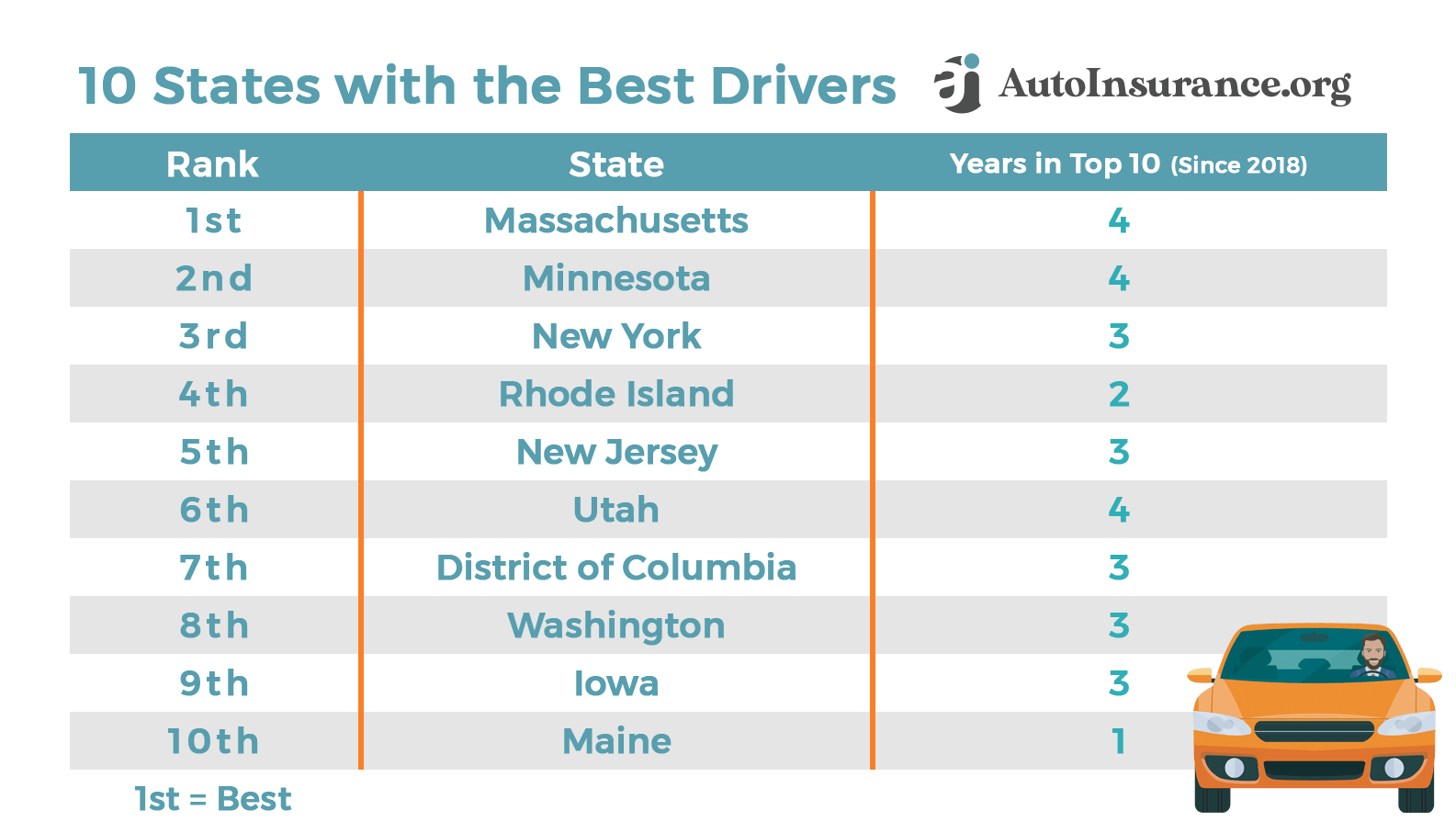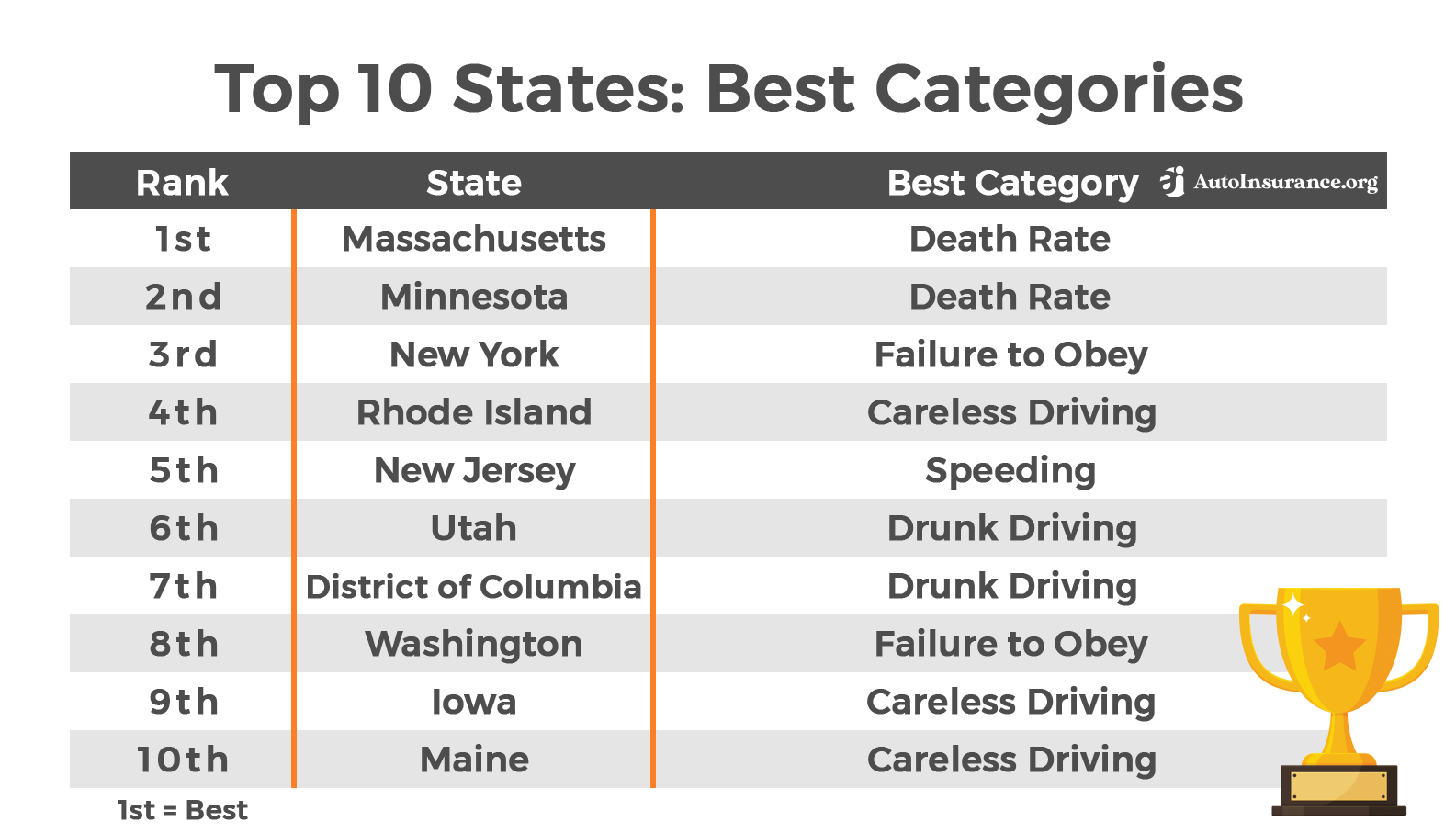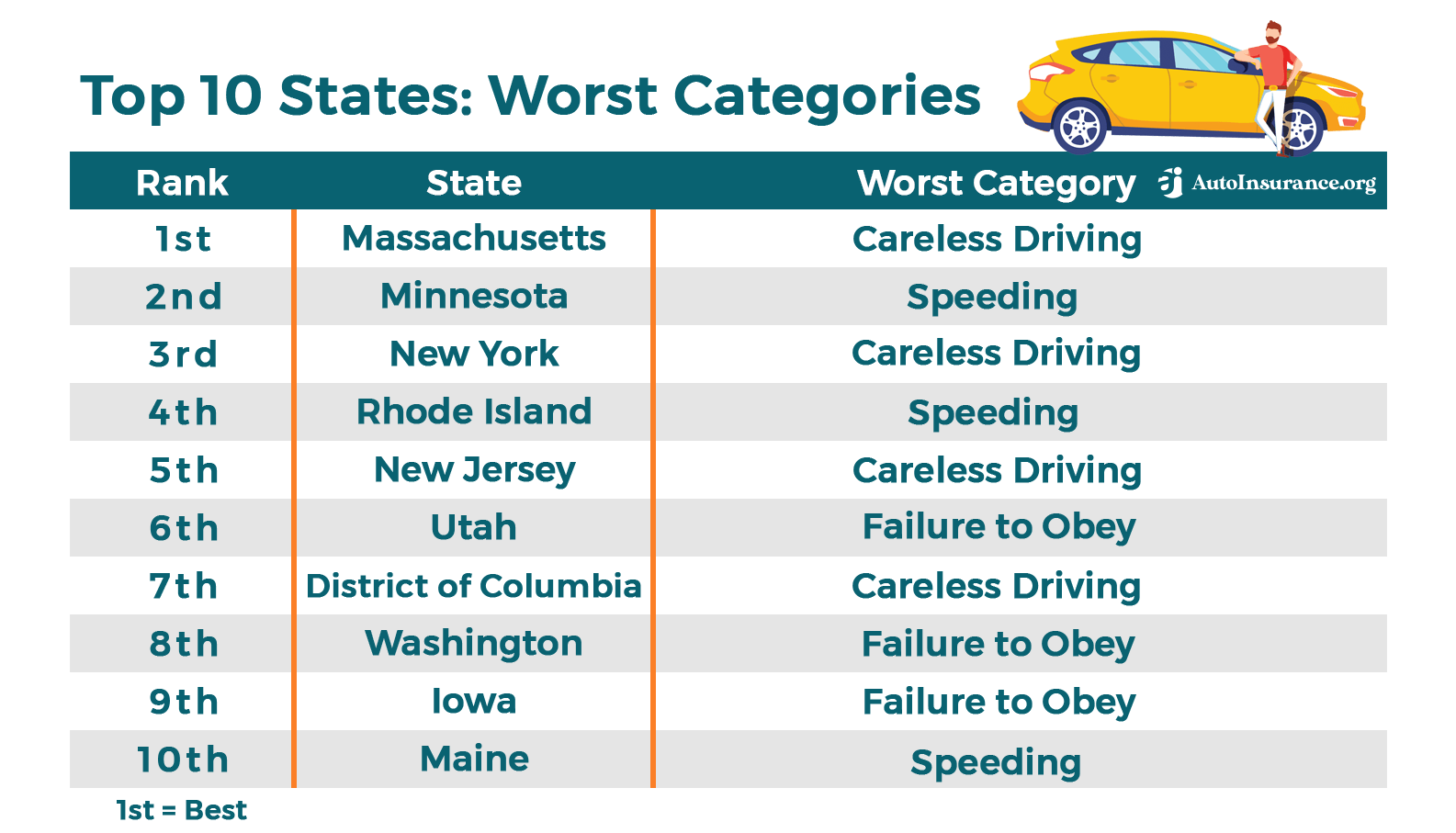8:00 - 17:00
Opening Hour: Mon - Fri

Everyone knows the bad driver. The one who cuts in and out of lanes at a high speed, merges into other lanes without looking over their shoulder, and rides the brake so that it’s difficult to see when they’ll stop.
But what about the great driver? While there are no awards given for the best drivers — after all, they are just doing their job — they should be valued, as communities, cities, and states have lower death rates because of them.
This article covers the 10 states with the best drivers in the United States because, in the end, these drivers make the roads in their communities, cities, and states safer.
Whether they speed less, are more careful about pedestrians, or obey traffic signals, these states are the cream of the crop. You can take a quick look at them in the graphic at the top of this page.
These 10 states with the best drivers are the most car-friendly states in the country. Hand in hand with these states having the best drivers is often lower auto insurance rates.
Find out more information about cheap auto insurance rates in your state and how you can save money on your current policy or when shopping for a new one.
Now, back to the ranking of the 10 states with the best drivers. Let’s get started.
Table of Contents
Who are the best states and what are they the best at? The following graph shows the best categories of the 10 states with the best drivers.
As is typical of our ranking, the state with the lowest number means their drivers were better. Massachusetts, for example, was rated No. 1 overall for all states, meaning it had the best drivers in the country.

Now, examine the 10 best states but from another angle: their worst categories. The following graphic shows those 10 best states and what categories each of them struggled with the most.
Unlike with the best categories for the 10 best states, the worst categories —or where the 10 states with the best drivers had the most trouble — were limited to three subcategories: careless driving, failure to obey, and speeding.

In none of the worst categories for the 10 best states were the subcategories of death rate and drunk driving. Already, the states (and the District of Columbia) with the 10 best drivers separate themselves from the other states by reducing the number of traffic deaths overall as well as those traffic deaths that occurred when at least one driver had been drinking.
Now, we’ll start with the ranking: the 10 states with the best drivers in 2021 including the state with the safest drivers overall. While some are perennial states in these rankings, others in this list of the safest drivers by state might surprise you.
Best Category: Careless Driving
Worst Category: Speeding
Maine, ranked 10th on this list of the 10 states with the best drivers, has its best category in careless driving, while its worst came in speeding.
In 2018, just nine pedestrians and bicyclists were killed in Maine for a combined death rate of one per 100,000 residents. Just one pedestrian or bicyclist was killed in 2018 per 100,000 Maine residents.
Maine had 42 speeding-related traffic deaths out of 137 total traffic deaths in its worst category (speeding). Total, there were three speeding deaths per 1,000 residents of Maine.
Speeding does more than just put other drivers’ lives at risk — It also can have a major impact on auto insurance rates. A speeding ticket can stay on your record for up to 36 months and add $45.46 to your monthly rate.
This means that a speeding ticket impacts your auto insurance rates significantly and forces you to pay well over $1,000 in increased rates over a 36-month period.
Best Category: Careless Driving
Worst Category: Failure to Obey
Ranked 9th on this list of the 10 states with the best drivers, Iowa has its best category in careless driving, while its worst score is in failure to obey.
In the careless driving category, only 29 pedestrians and bicyclists were killed in 2018, which amounted to 9 percent of its overall traffic deaths of 318.
Iowa fared much worse in the category of failure to obey with nearly eight traffic deaths per 1,000 residents occurring when a person didn’t obey a traffic signal, didn’t wear a seat belt, or had an invalid or illegal license.
Best Category: Failure to Obey
Worst Category: Careless Driving
Ranked 8th on this list of the 10 states with the best drivers, Washington has its best category in failure to obey with its worst category being careless driving.
Just four traffic deaths per 1,000 Washington residents occurred in the failure to obey category or when a person didn’t obey traffic signals, wasn’t wearing a seat belt, or had an invalid or illegal license.
However, 21.6 percent — or 118 out of 546 traffic deaths in Washington in 2018 — occurred in accidents involving a pedestrian or bicyclist. In total, two pedestrians or bicyclists were killed out of 100,000 residents in Washington.
Best Category: Drunk Driving
Worst Category: Careless Driving
The District of Columbia, ranked 7th in this list of the 10 states with the best drivers, has its best score in 2018 in the category of drunk driving. Its worst score came in the category of careless driving.
The District is remarkable in the issue of drunk driving, having ranked highly in this category for a number of years. In 2018, there were just 10 deaths overall involving a driver that had been drinking.
Nine of those came when a driver had a blood alcohol content (BAC) of 0.08 or higher, while one came when a driver had a BAC between 0.01 and 0.07.
Just 11 traffic deaths involved a driver that had been drinking. That’s 28.2 percent of all of the District’s traffic deaths in 2018.
Unfortunately, it struggles significantly within the category of careless driving, with 45.2 percent (or 14 traffic deaths out of a total of 31) of its traffic deaths coming in that category. Per capita, two pedestrians or bicyclists died in 2018 out of 100,000 residents.
Best Category: Drunk Driving
Worst Category: Failure to Obey
Ranked 6th in this ranking of the 10 states with the best drivers, Utah has its best category in drunk driving, while its worst category is failure to obey.
Utah had just 70 traffic deaths compared to the 260 traffic deaths it had overall in 2018.
Utah also made the list in our ranking of the best drunk driving rates by state with just 7,119 arrests for driving under the influence (DUI) in 2018. Keep in mind that this number is also influenced by the lowest legal BAC in the country at 0.06.
Utah has the harshest laws for drinking and driving, likely contributing to its high performance in this category for our ranking. Alcohol is also considered the worst driving hazard in America.
But, as much as it did well in the category of drunk driving, it struggled with failure to obey, with five traffic deaths per 1,000 people involved in accidents where a driver disobeyed a traffic signal, someone wasn’t wearing a seat belt, or at least one of the drivers had an invalid or illegal driver’s license.
Best Category: Speeding
Worst Category: Careless Driving
New Jersey, ranked 5th on this list of the 10 states with the best drivers, has its best category in speeding and its worst in careless driving.
Just 20.2 percent of New Jersey’s traffic deaths in 2018 involved a person speeding, which is 5.4 percent lower than the national average. Per capita, one traffic death occurred involving a person speeding out of 1,000 residents of New Jersey.
In what is a remarkable switch (as speeding is in general one of the top reasons for traffic deaths around the country), New Jersey’s traffic deaths involving pedestrians and bicyclists made up 33.9 percent of its overall traffic deaths in 2018.
Per capita, two pedestrians or bicyclists died in 2018 per 100,000 New Jersey residents. This issue of careless driving has been New Jersey’s Achilles’ heel, as it often performs greatly in the other subcategories.
Best Category: Careless Driving
Worst Category: Speeding
Ranked 4th on this list of the 10 states with the best drivers, Rhode Island has its best category in careless driving, with its worst category in speeding.
Only eight pedestrians and bicyclists were killed in Rhode Island in 2018 out of a total of 59 overall traffic deaths.
The death rate for pedestrians and bicyclists in Rhode Island amounted to one per 100,000 residents, the second-best rate out of all states.
However, it struggled in the speeding category, where 27 people died in traffic accidents, accounting for 45.8 percent of its overall traffic deaths. Its three deaths per 1,000 residents of Rhode Island is still better than most states, but its score in that category lags far behind its scores in other categories.
Best Category: Failure to Obey
Worst Category: Careless Driving
New York, ranked 3rd on this list of the states with the best drivers, has its best score in 2018 in the category of failure to obey, with its worst score in careless driving.
Within failure to obey, just three people per 1,000 New York residents were killed in accidents involving a driver not obeying a traffic signal, someone not wearing a seat belt, or at least one of the drivers having an invalid or illegal license.
Its worst category was careless driving, with 291 pedestrians or bicyclists were killed in New York in 2018, representing 30.9 percent of its overall traffic death total. Per capita, two pedestrians or bicyclists were killed per every 100,000 residents in New York.
While that is still better than most states, its category score in careless driving is much higher than its scores in other categories.
Best Category: Death Rate
Worst Category: Speeding
Ranked 2nd in this list of the 10 states with the best drivers, Minnesota has its best category in death rate (our first top 10 state to have its best score in that category) and its worst in speeding.
Its number of deaths per 100 million vehicle miles traveled is drastically lower than the average for all states and second-best out of every state within the country.
In its worst category — speeding — just 113 people were killed in accidents. This is 29.7 percent of its overall number of traffic deaths. Its per capita rate of two speeding-related deaths per 1,000 Minnesota residents is still better than 43 other states (including the District of Columbia).
Best Category: Death Rate
Worst Category: Careless Driving
Massachusetts, ranked 1st in our list of the 10 states with the best drivers, has its best category in death rate and its worst in careless driving.
Its death rate per 100 million vehicle miles traveled is the lowest of all states — over 100 percent lower than the average for all states.
In its worst category, careless driving, 82 pedestrians or bicyclists were killed in Massachusetts in 2018. This accounted for 22.8 percent of its traffic deaths for that year, creating a pedestrian and bicyclist death rate of one per 100,000 Massachusetts residents.
When you look at the 10 states with the best drivers, there may be similarities and differences that jump out at you. In fact, the average category rankings for all 10 states with the best drivers are above 7th for three of our five categories.
The average for the 10 states with the best drivers is over 10th just two times and represent the categories where the 10 states with the best drivers struggled the most. Here are the average rankings for the 10 states with the best drivers in all subcategories:
It’s easy to see that the 10 best states struggled with careless driving the most, with the states having an average ranking of 14 in that category.
The second-worst category where the 10 states with the best drivers struggled was speeding, where the average ranking for those 10 best states being 10.
Now, let’s dig a little deeper into the traffic deaths per category for the 10 states with the best drivers. How did the traffic deaths in the 10 states with the best drivers break down according to each category? Of their 3,599 traffic deaths:
An average of 83 traffic deaths in the 10 states with the best drivers were pedestrians or bicyclists compared to an average of 140 for all states. The per capita rate of pedestrians or bicyclists killed per 100,000 state residents was a little more than one traffic death for the 10 states with the best drivers compared to two traffic deaths for all states.
When it comes to issues like careless driving, some states may see a spike in pedestrian or bicyclist deaths during celebratory events or time periods like the holidays. For instance, we’ve seen that careless driving deaths can rise during Halloween, especially if that day is set on a weekday between Monday and Thursday.
Perhaps the most important category in our study was death rate, for which the 10 states with the best drivers did far better compared to the country overall. The average death rate for the 10 states with the best drivers was significantly lower than one average death or around 50 percent less than the average for all states.
When we looked at the 10 states with the best drivers as a whole, we wanted to see trends within that top 10, especially compared to the drivers in all states. But what are the trends for the country overall?
The following table shows each of our subcategories and how the nation overall fared in those categories compared to the 10 states with the best drivers. The statistics are from 2018.
| Best States vs. All States | Careless Driving | Drunk Driving | Speeding |
|---|---|---|---|
| All States Traffic Deaths | 7,140 | 10,512 | 9,378 |
| % of All States Total Deaths | 20% | 29% | 26% |
| 10 Best States Traffic Deaths | 830 | 1,239 | 830 |
| % 10 Best States Total Deaths | 23% | 34% | 28% |
What is interesting is that according to our analysis of the National Highway Traffic Safety Administration (NHTSA) data, the percentages of traffic deaths for those three categories are actually lower for all states compared to just the 10 best states.
Also, check out the graph below. It shows the ranking for all 50 states plus the District of Columbia for this 2021 study. The darker the blue, the better ranked a state was compared to the other states overall. The graph is interactive.
Hover your cursor over a state (if you’re on a desktop computer or laptop) or press down on a state with your finger (if you’re on a mobile device) to see the individual rankings for that state going back to our study in 2018.
As you can see clearly with the blown-up graphic, there are certain regions that have better drivers on the whole than others. The Northeast and Midwest, for example, typically have better driving scores than the West or the South.
The South tends to be the region with the worst driving scores due to a number of reasons like deteriorating infrastructure or cultural driving distances.
Now, take a look at the graph below. This shows each state’s best categories: first-best and second-best. There, you can see which states performed best in death rate for instance and which states performed best for speeding.
It’s also interactive, so hover your cursor above a state or press down on the state with your finger to see individual state results.
Drunk driving and speeding continue to be major problems nationwide, with the two generally leading every year as the causes for traffic deaths, even though drunk driving traffic deaths have been declining since 1991 by a total of over 50 percent for drivers of legal drinking age.
Even when comparing this year’s study results to previous years, the Northeast is the region with the best drivers, followed by the Midwest, the West, and the South. The average ranking for each region is:
As a contrast, the South has seven states in the bottom 10 slots in the ranking, while the Northeast has five states in the top 10 of all states. The South seems to have problems year after year in these rankings with its worst categories in this ranking being death rate, failure to obey, and careless driving.
Of course, with a list of the 10 states with the best drivers, there are always states at the bottom — the worst drivers.
South Carolina is among the worst states to drive through and often ranks at the very bottom (or close to it) in states with the best drivers lists. It also has some of the worst highways, contributing to traffic deaths.
South Carolina also made our list as the No. 1 worst state for traffic-related fatalities in America. Five states from the South — Kentucky, Florida, Louisiana, Mississippi, and Alabama — joined South Carolina in the top 10 of the worst states on that ranking, showing again that the South continues to be the region with the worst drivers year after year.
In addition to the categories we covered in this study of the 10 states for best drivers, there are other factors that impact death rates within states. One of those involves vehicle defects that put drivers’ lives at risk.
There’s little doubt that the 10 best states for driving have a great number of things in common. Generally, they are high performers in numerous categories, with just a maximum of one bad score in all five categories.
High-risk behavior like drunk driving and speeding are often mitigated in states with the best drivers. Per capita traffic deaths are much lower on the whole when compared to the rest of the country.
The same states often appear year after year on these 10 states with the best drivers rankings. They may flip-flop or move around in individual rankings, but the states that have the best drivers often have so for years on end. Why are these states consistently the best out of the country?
It may be partly due to driving culture, with the Midwest — our second-best region — known for its polite and careful driving style. It may be due to the infrastructure, with states in the South or West suffering from a lack of care for roads and highways, which can lead to accidents.
There may be more awareness in the states with the best drivers of major causes of traffic deaths like drunk driving, speeding, or careless driving and the consequences of being arrested for those offenses.
The issue is too broad to have a single cause, most likely. But a lot can be analyzed from the 10 states with the best drivers to apply to the states with the worst drivers to raise the bar for all drivers and save lives in the process.
Now that we’ve gone through the 10 states with the best drivers along with the trends in those states and nationwide, keep scrolling to hear from professionals all over the world. They cover the driving issues in their area along with how their community or government is promoting good driver behavior.

What are some good driving behaviors?
“Being courteous to other drivers seems obvious. The worst driving behaviors these days are due to cell phone distractions.
Drivers Ed teaches new drivers to pass the test. But realizing that you are driving a 4,000-pound machine that offers tons of safety features that people don’t learn about or use.”
What are some ways drivers can improve their driving behavior?
“Use the high-tech safety features like backup cameras, blind-spot detection, active cruise control, and more. Understanding how they work and how they can save a life is critical to your driving habits.
The media is always pushing self-driving cars, but there is no such thing on the road. You are the driver. It’s your responsibility to focus on the road.”
How has technology helped drivers improve their driving behavior?
“When buying a vehicle, never skimp on safety features. That safety is part of technology. Many new cars will even track your vision to avoid distractions.”
How can the police affect and improve driving behavior for drivers in their community?
“The service of child safety seat installations could be promoted.”
How can public officials improve driving behavior in their community? Are there any effective campaigns where you live?
“Retesting drivers should be mandated like in Europe. Safer drivers equal lower insurance rates for all.
The new campaigns to limit road width and add bike lanes actually increases the frustration of drivers who then make aggressive moves in no-passing zones. Four-lane roads should remain that way.”
How can auto insurance companies work to better their policyholders’ driving behaviors?
“Mandating bad drivers get retested and learn better skills.”
What are some of the challenges drivers will face in the next five to 10 years that could affect their driving behavior?
“Drivers getting lazy due to the driver-assist systems. You still have to pay attention, and some of these systems allow you to look away. This may create issues in a few years. You have to practice a skill to be good at it.”
What are some of the driving behaviors you work on to become a better driver on the road?
“Learning how a vehicle handles in multiple weather conditions. Accident avoidance and focusing on the road. Performance driving schools are very helpful for these skills.”
 Lauren Fix is an auto expert and owner of Car Coach Reports.
Lauren Fix is an auto expert and owner of Car Coach Reports.
She is a race car driver and author of three award-winning automotive books.
What are some good driving behaviors?
“One thing that people may forget about doing that can impact their driving is simply making sure that the vehicle itself is safe. You should aim to do routine wellness checks of your car’s vitals and tires to make sure your car is always performing at its best, which will ensure you’re driving your best, too.
That said, some of the best driving habits come from adhering to the driving advice that we’ve all heard before:
Slow down! They say speed often is the cause of close to 20 percent of all injuries. Going the speed limit is one way to ensure both your and other drivers’ safety.
Always wear a seat belt. Keep your eyes on the road. Distracted driving can be fatal.”
What are some ways drivers can improve their driving behavior?
“You can enhance your driving behavior by learning from the pros, You can take a course — YouTube or other online resources are a great start, Or, when it’s safe to do so, head to a school or hire a driving instructor.
They’ll share tips and tricks that you may not have thought of to ensure you’re driving safely. Also, practice makes perfect. Head to a mall parking lot and practice your techniques. This could be especially helpful when you’re practicing driving in inclement weather.”
How has technology helped drivers improve their driving behavior?
“Technological advancements in automotive design and amenities have armed drivers with new ways to enhance their driving. Your tires are typically your first line of defense for safe driving, and the tire industry has been using technology to improve the safety of tires for drivers of all kinds.
One example of that advancement is run-flat technology, which allows drivers who sustain air loss due to a compromised tire to drive approximately 50 miles at 50 mph so they’re able to get to a safe place to change their tire.
Most cars themselves now have built-in safety features, like backup assist and sensors that automatically stop the car in potential crash situations. These can reduce the number of accidents.
Plus, since the use of cellphones is now prevalent and poses a threat to safe driving, many providers have created applications that can assist with safer driving, like disabling texting when the car is in motion or notifications when the driver is speeding.”
How can the police affect and improve driving behavior for drivers in their community?
“I think there are two clear opportunities for police to help improve driving behavior in their communities. Offering driver training and practice courses for free to members of the community could help promote the importance of learning good driving habits and honing your skills.
Also, they can monitor high traffic areas where bad behavior and accidents are prevalent not only to help slow the situation down but also to get an understanding of why the bad behaviors happen and create solutions to help curb them.”
How can public officials improve driving behavior in their community? Are there any effective (or ineffective) campaigns where you live?
“Similarly to having police keep an eye on high traffic areas, I believe that public officials with a broader scope should monitor high-accident areas to assess if there are infrastructure changes needed to help improve them.
They can also lower speed limits in certain areas to promote slowing down traffic. Some effective campaigns that worked in my community in Southern New Jersey include the introduction of speed bumps in areas that were infamous for speeding and the regular addition of stop signs or traffic lights in intersections that were being more highly trafficked.”
How can auto insurance companies work to better their policyholders’ driving behaviors?
“One effective way I think auto insurance companies can help encourage good driving is to reward this behavior. They can offer rebates on policy for successfully completing a safe driving course or reward policyholders when they meet certain safe driving milestones, like going a set amount of time without any incidents or infractions.”
What are some of the challenges drivers will face in the next five to 10 years that could affect their driving behavior?
“There are a lot of challenges on the horizon that could impact drivers. The COVID pandemic created more urban sprawl, providing the opportunity for many to move out of the city and into the suburbs. This, along with the rise in people’s wariness to travel by public transit and rideshare services due to the virus, has resulted in more people purchasing cars.
A study released by Google’s Human Truths team found that more than 3 million people who don’t currently own a car are considering purchasing one. That means more ‘new’ drivers on the road, more cars, and more chances for incidents.
Electric cars are also on the rise. But, what new electric car drivers may not know is that these cars have high torque, meaning they are very fast. This new-found speed may also lead to more accidents.
Finally, road damage could have a part to play in making driving more challenging in the future. As we have dramatic changes in the climate throughout the year, plus more cars on the road, the conditions of the roads can suffer.
Things like potholes, large cracks and, in some parts of the country, the introduction of new weather patterns, more snow and more rain, can all cause danger for drivers.”
What are some of the driving behaviors you work on to become a better driver on the road?
“As a business owner, husband, and dad of two, there can be a lot of distractions when I’m in the car from ringing phones to little voices with lots of questions. Paying undivided attention to your driving is one of the most important things you can do as a driver, not only for yourself but for other drivers too.
While I may not be able to control what other drivers are doing on the road, I can always make sure that I am prepared, paying attention and always on the lookout for potential dangers.”
Do you have a story involving good driving behavior that kept you from getting in an accident or other incident?
“Similar to the point above, I was driving once on a four-lane road and I noticed the car next to me was a younger person playing on their phone. The light ahead of us turned red, and the car went through the red light and crashed into a pole after avoiding hitting a car coming in the other direction.
Luckily no one was hurt, but if I was distracted on my phone like the person next to me, I may have not been so lucky.”
 Josh Chalofsky is the co-founder and chief operations officer at SimpleTire.com.
Josh Chalofsky is the co-founder and chief operations officer at SimpleTire.com.
SimpleTire is a tire e-retailer founded by two brothers who grew up in the tire business.
“Awareness is the Key to Safe Driving
Safe driving starts with establishing the proper mentality. Striving to be a defensive driver with the ability to react to others around you should be the goal of every driver. With the advent of technologies such as lane assist and blindspot cameras, it has never been easier to be in tune with your dynamic surroundings.
Knowledge and proper training are vital to building the type of confidence and awareness that is necessary to be successful in safe roadway navigation.
Cities and states that focus on stringent testing before issuing licenses are successful in filtering out poor driving behaviors before they hit the streets.
Auto insurance companies can also incentivize safe defensive driving by offering steep discounts to policyholders who consistently avoid traffic infractions.
Police presence on the roads is an example of an unsuccessful campaign against bad drivers. Patrol cars can weaken the confidence of some drivers and may even divert their attention away from the road. In addition, policing is reactionary by nature.
No amount of police will be proactive in helping drivers improve their awareness and anticipation.
The future of cars and trucks is inching closer and closer to full automation. In the next five to 10 years, we will see more self-driving cars and smart vehicles that are transmitting data between each other in real-time.
Technology should offer a chance to improve safety and reduce traffic, while also eliminating the risk of human error.
The main driving behaviors I focus on to be a better driver stem from awareness and anticipation. Awareness means I must analyze the whole picture of my surroundings, not just the car immediately in front of me.
I continuously scan my mirrors and look for hazards that I might encounter up ahead. Maintaining a level of awareness helps me anticipate what other drivers will do and keeps me prepared to react properly.
Just the other day I was approaching a red light and noticed the driver to my right side had his blinker on, intending to change into my lane. I was positioned awkwardly in his blind spot at the time and knew he may not be able to see me. I braked harder than usual in an attempt to give him the lane ahead.
Sure enough, he shifted lanes as I had expected. I was aware of the situation from my perspective and his, and I was then able to properly anticipate what he would do next. By simply adjusting my braking distance I was successful in avoiding a collision.”
 Julian Goldie is the CEO of Goldie Agency, a site dedicated to SEO and link building.
Julian Goldie is the CEO of Goldie Agency, a site dedicated to SEO and link building.
As a commercial vehicle driver, Julian earned certifications in safe driving techniques.
What are some good driving behaviors?
“Some main good driving behaviors are to avoid speeding, do not drink and drive, have a plan B, avoid distractions or being distracted on the road, do not drive when you are tired or sleepy, wear your seatbelt, ensure all passengers are wearing seatbelts, drive with caution in wet weather, and remain a safe three-second stopping distance from the driver in front of you.”
What are some ways drivers can improve their driving behavior?
“To improve bad driving behaviors drivers should just focus on their own driving rather than road raging at other drivers (which is another distraction on the road). Drivers should be extra attentive to their own driving as that is the only thing they can control on the roads.
They are not able to control the actions of other drivers, only working around the actions of other drivers. In a perfect world, there would be no errors from other drivers on the road, but that is just not how the world works.”
How has technology helped drivers improve their driving behavior?
“As technology is ever-evolving, there are many new features in cars which assist drivers in avoiding accidents — for example, sensors, automatic brake systems, and rear-view cameras.”
How can the police affect and improve driving behavior for
drivers in their community?
“Police are able to affect and improve driving behaviors by educating those who do not follow the regulations and laws in place. Rather than just punishment, there should be some form of education towards people who disobey or are ignorant of the driving rules.”
How can public officials improve driving behavior in their community? Are there any effective (or ineffective) campaigns where you live?
“Public officials should offer more education on the safety of driving. There are many effective campaigns in Australia on drinking and driving. These ads are hard-hitting and show the damages drink driving can cause.”
How can car insurance companies work to better their policyholders’ driving behaviors?
“Auto insurance companies can work to better their policyholders’ driving behaviors by sending out informative EDMs to their customers. These gentle reminders on how to avoid terrible accidents may assist in keeping the policyholders’ premiums down.”
What are some of the challenges drivers will face in the next five to 10 years that could affect their driving behavior?
“Driving challenges in the next five to 10 years may be the increased technology in self-driving cars with many safety features. These can actually harm some drivers as they take away from the actual skill of human driving and the importance of being aware while driving, which prevents many accidents.
This reliance may affect the ability of a human to drive on their own without technological help.”
What are some of the driving behaviors you work on to become a better driver on the road?
“Some good driving behaviors for myself which I focus on is being extremely alert and cautious while driving on the roads.
I have taught myself that I must be extremely aware of my surroundings because, no matter how good my driving is, I am only as safe as the other obstacles around me.”
Do you have a story involving good driving behavior that kept you from getting in an accident or other incident?
“One good driving behavior that has prevented me from getting into an accident is being extremely cautious when I am driving at night, making sure I am extremely aware of my surroundings and my vision is clear when I am driving.
For example, one time driving from Sydney to Perisher — which is a six-hour drive on a highway with many animals — a kangaroo jumped out of nowhere and hopped onto the road. I braked just in time when I saw it in my high beams.”

Michelle Ren is an online community manager for Budget Direct Insurance.
Budget Direct provides auto insurance to millions of policyholders worldwide.
What are some good driving behaviors?
“Drive the speed limit, stay alert, be a defensive driver, make adjustments as conditions change, stay away from the cell phone, be patient, and do not drive while impaired.”
What are some ways drivers can improve their driving behavior?
“Take a driver safety course, and have your insurance company track you with a telematics device. When you know someone is watching you will hopefully change your behavior. Another way to improve is to practice.”
How has technology helped drivers improve their driving behavior?
“My car has accident avoidance sensors all over the place and has alerted me when a car drifts into my lane. I am able to make adjustments on the fly to avoid a potential accident.
Also, the blind spot sensor on my side mirrors has really helped me to check for cars in my blind spot before I change lanes.”
How can the police affect and improve driving behavior for drivers in their community?
“The police can educate people on the rules of the road. It’s been a long time since I took my driver’s test and I think I could benefit from a traffic law refresher course or tips on how to stay safe.”
How can public officials improve driving behavior in their community? Are there any effective campaigns where you live?
“Education is the key. Yes, here in Arizona there are reader boards on the freeway that say ‘Drive hammered, get nailed.’ Those types of campaigns are great.”
How can auto insurance companies work to better their policyholders’ driving behaviors?
“It comes down to money with the insurance companies. If I am a safe driver, I should have better rates than someone who is not a safe driver. The insurance companies need to reward safe drivers.”
What are some of the challenges drivers will face in the next five to 10 years that could affect their driving behavior?
“As populations increase, there will always be more and more drivers on the road.”
What are some of the driving behaviors you work on to become a better driver on the road?
“I have worked on slowing down and being more patient. My son started driving a little over one year ago and I have to be a good example for him.”
Do you have a story involving good driving behavior that kept you from getting in an accident or other incident?
“Just the other day, an aggressive driver drifted into my lane. I kept my calm, slowed down, and made sure I honked my horn so the driver knew I was there.”
 Steve Morrow is the founder of the kayaking website, Paddle About.
Steve Morrow is the founder of the kayaking website, Paddle About.
Teaching his son how to drive improved his own driving behavior.
“As a car expert, I am always on the lookout for how different countries and places deal with driving laws and guidelines. The U.S. has made great improvements in driving behaviors by introducing a higher drinking age. However, there is more it can do.
In the U.K., for example, auto insurance is a way to tackle irresponsible driving. The driver needs to be the one insured onto the car. They can only drive the car that they are insured on and depending on the driver’s age the insurance can be extremely expensive. Especially if they are hoping to drive a fast car without a black box.
The insurance goes down after the age of 25 and that is the age a lot of studies suggest is when drivers start to be more sensible.
Another great example from Europe is how they approach drivers who have broken the law. Many first time offenders who were speeding are required to sit a mandatory course that teaches them in-depth about the dangers and potential outcomes of their behavior. Those sound tedious but work very effectively.
Implementing black boxes and cameras in a vehicle is a sure way for insurance companies to have more control over the behaviors of drivers.
Another very beneficial practice in some European countries is mandatory Red Cross training days. Those range from half a day to three-day events depending on where you live and are in often cases mandatory to obtain a driving license.
During these training days, you learn how to offer help during the time an ambulance arrives. The nature of the event means that people become familiar with car crashes and are more inclined to avoid them as much as possible.”
 Shayne Sherman is a vehicle expert and the CEO of Car Passionate.
Shayne Sherman is a vehicle expert and the CEO of Car Passionate.
His site provides maintenance advice, repair how-tos, and car part reviews.
“Stay off your phone while driving…use it to save money every month instead.
For the past couple of years, the biggest technological change I’ve seen in the insurance industry is the introduction of telematics.
Telematics can be apps or devices that insurance companies use to monitor safe driving behaviors — speeding, hard braking incidents, whether you drive in rush hour vs. off-peak times, and how often you use your cellphone while driving.
I’ve worked for several different insurance companies, and they all give a discount for signing on and using their telematics program. Farmers has Signal, State Farm has Drive Safe and Save, Allstate with Drivewise, and so on and so forth.
They’re all little apps that you install on your smartphone, then you just do your normal thing and drive around town. Insurance companies offer you a discount on rates depending on how safe you are as a driver.
I’m a pretty safe driver, so I save about $14 a month on my insurance. My husband, on the other hand, has a bit of a lead foot and only saves about $8 a month. Still, a $22 dollar-a-month savings on our auto insurance really adds up.
The carrot at the end of the stick is threefold. The insurance company gets data on how its customers actually drive and can adjust things as needed. The customer gets a discount and wants to participate in the program.
And the telematics app actually makes the customer aware of their driving habits: how often you use your phone (distracted driving), how often you speed (aggressive driving), or how often you hard brake (not following a safe distance).
I know I get an alert if I was messing with Spotify too much at stoplights on the ride home. It’s a good reminder that even though I’m an insurance agent, I still have things I could improve on to be a safer driver.
As the world becomes more digital, telematics technology becomes even more important.
Newer insurance companies already use telematics exclusively to rate policies and have moved away from traditional underwriting methods.
Established companies are starting trial programs with telematic-only policies while keeping the ‘regular’ policies going.
In the future, I hope for self-driving cars (mostly so I can nap on the way to work!) so that we don’t have to worry about distracted driving the way we do now.
In the meantime, I’ll take telematics. Anything that insurance companies can do to make drivers more aware of their actions on the road is fine by me.”
 Spenser Cheatham is a marketing and sales manager at Caballaro Agency.
Spenser Cheatham is a marketing and sales manager at Caballaro Agency.
Caballaro provides auto, home, life, and health insurance coverage in Texas.
“One of the biggest cultural trends of the past decade has been the addition of smartphones to our day-to-day lives. As a result, incidents of distracted driving have been steadily on the rise.
It can be tempting when all seems calm on the roads to take a quick glance at your cellphone notifications, but it’s important to remember that driving is a task that takes all of your attention, and shifting focus even for a second could result in an accident.
That’s why it’s imperative to safe driving behavior that drivers keep their phones tucked away and out of sight while on the road. But the sharp increase in distracted driving is not entirely in your control.
Even when you practice best driving behaviors, you have to bear in mind that other drivers may not be as diligent in their focus. It’s best to follow all traffic laws and right-of-ways, but you must also keep a close eye on other drivers to ensure they are correctly yielding right-of-ways as well.
The other driver will be at fault if they are distracted and blow through an intersection, causing an accident, but being hyperaware on your end can help you avoid the accident altogether.
After all, preventing an accident altogether can save time, money, and protect you from potential injury. If you spot a driver acting erratically, whether they’re weaving in and out of lanes or driving too fast (or even too slow) for the flow of traffic keep your distance and keep your eyes on the road.”
 Jake McKenzie is the content manager at Auto Accessories Garage.
Jake McKenzie is the content manager at Auto Accessories Garage.
This family-owned business sells automotive parts and accessories.
“Auto Insurance Providers Role in Improving Driving Behaviors
In order to better policyholders’ driving behaviors, auto insurance companies need to incentivize good behavior.
Auto insurance companies can more accurately work through claims because footage at the scene of an accident exists if the driver installs cameras or a dashcam.
One of the worst parts of an accident is explaining your side of the story to an insurance company when there is no evidence to support your story. It is difficult to describe the context of an accident and often it comes down to a ‘he said, she said’ scenario.
Dashcams are the most unbiased witness at the scene of an accident. It doesn’t have an ulterior motive and its sole purpose is to record road footage. It is so unbiased that it can actually work against the driver who installed the dashcam.
As more dashcams are utilized, drivers will begin to notice that there’s an increasing likelihood of being recorded on the road and will discourage bad behavior. This describes the classic phrase of ‘addition by subtraction.’
Discouraging bad driving behavior, which can be captured on a dashcam, ultimately promotes good behavior, making the roads safer and saving lives. Dashcams can fit every type of vehicle and every price range. From a driver’s point of view, a small investment can pay big dividends in the long run.
And if auto insurance companies provide a lower premium for incorporating a dashcam, that choice pays for itself. Insurance companies themselves will see a financial return on this decision as claims will become more precise and customer satisfaction should rise.
Auto insurance companies should be promoting road transparency which will, in turn, promote good driving behavior.”
 Christopher Lee is the owner of Eyewitness Dash Cams.
Christopher Lee is the owner of Eyewitness Dash Cams.
He writes on how dash cams benefit road safety, insurance claims, and traffic stops.
If your state wasn’t featured in the 10 states with the best drivers, you’re probably anxious to know where your state stands. The following table shows each state with its category scores for death rate, failure to obey, careless driving, drunk driving, and speeding.
| State | Death Rate | Failure to Obey | Careless Driving | Drunk Driving | Speeding | 2021 Rank |
|---|---|---|---|---|---|---|
| Massachusetts | 1 | 2 | 13 | 3 | 2 | 1 |
| Minnesota | 2 | 7 | 4 | 6 | 8 | 2 |
| New York | 5 | 1 | 18 | 2 | 3 | 3 |
| Rhode Island | 4 | 3 | 2 | 8 | 20 | 4 |
| New Jersey | 3 | 6 | 35 | 3 | 1 | 5 |
| Utah | 6 | 16 | 14 | 3 | 11 | 6 |
| District of Columbia | 7 | 4 | 31 | 1 | 10 | 7 |
| Washington | 9 | 5 | 21 | 7 | 13 | 8 |
| Iowa | 16 | 20 | 5 | 12 | 7 | 9 |
| Maine | 11 | 9 | 1 | 18 | 27 | 10 |
| Ohio | 11 | 19 | 16 | 9 | 16 | 11 |
| Maryland | 7 | 10 | 37 | 13 | 9 | 12 |
| Connecticut | 11 | 8 | 26 | 19 | 18 | 13 |
| Nebraska | 26 | 27 | 15 | 17 | 5 | 14 |
| Michigan | 15 | 23 | 24 | 17 | 14 | 15 |
| Virginia | 16 | 17 | 20 | 16 | 24 | 15 |
| Illinois | 16 | 18 | 17 | 13 | 31 | 17 |
| Wisconsin | 10 | 24 | 7 | 27 | 29 | 18 |
| California | 19 | 14 | 41 | 15 | 12 | 19 |
| New Hampshire | 22 | 12 | 3 | 22 | 42 | 19 |
| Vermont | 11 | 14 | 6 | 31 | 39 | 19 |
| Idaho | 36 | 27 | 10 | 19 | 21 | 22 |
| Kansas | 33 | 29 | 12 | 9 | 30 | 22 |
| Pennsylvania | 28 | 20 | 25 | 11 | 34 | 24 |
| North Dakota | 22 | 26 | 9 | 25 | 43 | 25 |
| Hawaii | 22 | 12 | 45 | 21 | 35 | 26 |
| Indiana | 20 | 37 | 32 | 24 | 23 | 27 |
| Oregon | 39 | 11 | 33 | 39 | 22 | 28 |
| Tennessee | 34 | 39 | 34 | 33 | 15 | 29 |
| Georgia | 27 | 36 | 42 | 32 | 19 | 30 |
| Nevada | 28 | 30 | 43 | 30 | 26 | 31 |
| Colorado | 28 | 41 | 30 | 23 | 36 | 32 |
| Delaware | 25 | 39 | 44 | 25 | 31 | 33 |
| Florida | 40 | 37 | 49 | 34 | 4 | 33 |
| South Dakota | 37 | 32 | 11 | 38 | 46 | 33 |
| West Virginia | 47 | 25 | 19 | 34 | 41 | 36 |
| North Carolina | 31 | 34 | 38 | 36 | 28 | 37 |
| Kentucky | 45 | 51 | 27 | 29 | 16 | 38 |
| Wyoming | 21 | 44 | 8 | 50 | 50 | 39 |
| Missouri | 32 | 42 | 22 | 36 | 47 | 40 |
| Alaska | 45 | 22 | 28 | 43 | 45 | 41 |
| Texas | 35 | 33 | 39 | 44 | 33 | 42 |
| Montana | 42 | 35 | 23 | 45 | 49 | 43 |
| Oklahoma | 44 | 43 | 29 | 41 | 37 | 43 |
| Mississippi | 50 | 50 | 46 | 49 | 6 | 45 |
| Arizona | 48 | 31 | 47 | 39 | 38 | 46 |
| Arkansas | 40 | 47 | 36 | 46 | 40 | 47 |
| Louisiana | 48 | 46 | 50 | 42 | 25 | 48 |
| Alabama | 37 | 49 | 39 | 46 | 44 | 49 |
| New Mexico | 42 | 44 | 51 | 51 | 48 | 50 |
| South Carolina | 51 | 48 | 48 | 48 | 51 | 51 |
In our ranking, the state with the higher rank has the better drivers. For instance, because Massachusetts is ranked No. 1, it has the best drivers overall in the country.
To calculate each state’s category score, our analysts broke down each category into different parts and assigned the state a score for each part. For instance, the main statistic for the category ranking of careless driving is the per capita number of pedestrian and bicyclist deaths within a state.
The number of pedestrian and bicyclist deaths in a state for our 2021 study was divided by the number of residents of that state — specifically 100,000.
This per capita number is essentially the number of deaths per portion of the population, which helps to give an accurate statistic to rank all states. The gap between the states with the best drivers and the states with the worst drivers is large, although certain regions, like we’ve covered, perform better than others in the overall rankings.
Of course, these categories — in particular, death rate — don’t have just an effect in how safe you are on the roads. They also affect auto insurance rates, as communities, cities, and states that have a high number of fatal crashes can have higher auto insurance rates as more people are filing claims.
Fortunately, there are ways to combat this if you are a good driver. Applying to be a part of your insurance company’s telematics system is one of those options.
With that system, your auto insurance company can evaluate your driving and how safe you are, which can reduce your auto insurance rates. Auto insurance companies will often offer a discount of up to 30 percent on your rates when you use a telematics system and if you’re a perfect driver.
There are also a number of auto insurance discounts to save you money. These include the accident-free discount, the vanishing deductible discount, the good driver discount, and the defensive driver discount. These can all lower your auto insurance rate, even if you don’t live in one of the 10 states with the best drivers.
When it comes to the states with the best drivers or where your state falls in this year’s rankings, there are always questions that come with such a ranking. In this section, we’ll answer some of those questions. They include:
That’s not all. There are more questions that we answer below.
In our study of the 10 states with the best drivers, Florida is actually tied for 33rd with Delaware and South Dakota. It has lower than average scores for four of our categories but excels in the speeding category, where it ranks 4th throughout the entire nation.
Florida, unfortunately, also has the worst total deaths on U.S. highways between 2010 and 2017, taking up the first seven spots in the ranking for the top 10 U.S. highways for intersection deaths.
When it comes to which age groups have the safest drivers, the answer, literally, is in the middle. Drivers in middle age — roughly 30 to 40 years old — tend to have some of the lowest insurance rates, in part because they are involved in fewer accidents. They represent the age group that has enough experience to drive safely (compared to teenagers) and don’t yet suffer the physical and mental issues that can plague older drivers.
The age group that is most likely to crash a car is teenagers, who have sky-high insurance rates because of their inexperience and increased likelihood of taking a risk such as drunk driving or texting while driving. All of these can lead to more traffic deaths, making them the most dangerous drivers on the road, even compared to the elderly, which have a number of problems associated with their ages as well.
According to numerous sources such as the authoritative Insurance Information Institute, male drivers are more likely to be involved in car crashes than female drivers, including fatal car crashes. Part of the reason for this is that male drivers are more likely to take risks such as drinking and driving or speeding recklessly, which puts them in danger as well as any other motorists on the road.
For this reason and others as well, male drivers often receive higher insurance rates than female drivers because they are more likely to file a claim.
All states currently have speed limits on all roads, although Montana and Nevada were two of the final holdouts until Congress mandated speed limits on all roads. In the West, there are places where the speed limit is posted as 80 miles per hour and within Texas, a highway recently opened up that allows for speeds up to 85 miles per hour.
Texas State Highway 130 is the fastest place you can drive in the United States, with a posted speed limit of 85 miles per hour. It is also called the “Pickle Parkway” and was created to relieve some of the traffic on I-35 from San Antonio to Austin.
However, while it is considered the fastest place you can drive (on public roads) in America, there are still a number of toll stops, which can slow down traffic. In the past, there have also been collisions with wild hogs.
While laws encourage people to enter the left-hand lane (or left-hand side of the street) to pass a car, it is still breaking the law technically if you are speeding, and a law enforcement officer can still pull that driver over.
These situations can also be dangerous at night since it is difficult to gauge the distance of oncoming traffic with few markers or around sharp bends. This often results in accidents, sometimes fatal ones.
In the past — and still in use in many places today — drivers would flash their lights at incoming traffic to communicate that there was a police officer hiding, ready to pull someone over and give them a ticket.
While this has been the subject of legal proceedings, the Supreme Court has ruled that banning this practice would be against the First Amendment or the people’s right to free speech and expression.
In our study of the 10 states with the best drivers, our analysts collected data about the five following categories:
Using those five intricate driver categories, which were made up of 48 subcategories, we were able to break down exactly where driving strengths and weaknesses lie, and which states have the best drivers overall.
Each of those categories had at least one subranking that helped determine the state’s ranking for that category. For instance, in the category of failure to obey, our state with the best drivers, Massachusetts, had three subcategory ranking scores:
The subrankings were then summed: 15 in the case of Massachusetts. This summed subranking was then compared to the summed total of other states. Massachusetts was ranked second-overall in this category because New York — the No. 1 ranked state in this category — had a summed subcategory score of 11.
From this subcategory summed total, our analysts ranked each state. Our experts also employed per capita statistics as well to determine the ranking in each category.
An example is in the category of careless driving, with the final determining statistic for the ranking was per capita traffic deaths of pedestrians and bicyclists per 100,000 in-state residents — in other words, how many pedestrians and bicyclists were killed per 100,000 residents.
For these statistics, lower was better. Rhode Island’s per capita rate for this category was 0.76, which ranked second overall for all states. West Virginia, with a 1.5 per capita rate, ranked 19th because it had a higher rate not just compared to Rhode Island but 17 other states.
In this study, our experts compiled and analyzed over 1.2 million data points to give all 50 states plus the District of Columbia, a comprehensive driving score.
Most of the statistics came from the National Highway Traffic Safety Administration (NHTSA), though we also included statistics from the Insurance Information Institute (III). While the data came from these two authoritative sources, our analysts did the heavy lifting, coming up with rankings and trends for all of these categories.
Features